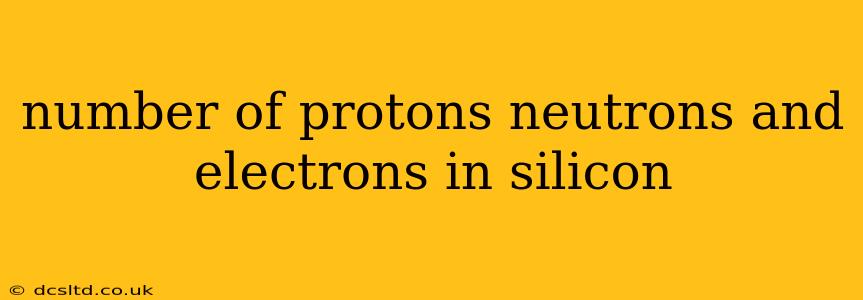Silicon, the heart of the microchip revolution and a crucial element in the Earth's crust, holds a fascinating subatomic structure. Understanding the number of protons, neutrons, and electrons in a silicon atom is key to comprehending its chemical properties and behavior. This article delves into the details, answering common questions and providing a comprehensive overview of silicon's atomic composition.
How Many Protons Does Silicon Have?
Silicon's atomic number, 14, dictates the number of protons residing within its nucleus. The atomic number is the defining characteristic of an element, representing the number of protons in each atom of that element. Therefore, silicon has 14 protons. This positive charge is crucial for the atom's overall stability and interactions with other atoms.
How Many Neutrons Does Silicon Have?
Unlike the consistent number of protons, the number of neutrons in silicon can vary. This leads to the existence of isotopes. Isotopes are atoms of the same element with the same number of protons but a different number of neutrons. The most common isotope of silicon, Silicon-28 (²⁸Si), has 14 neutrons. However, other stable isotopes exist, such as Silicon-29 (²⁹Si) with 15 neutrons and Silicon-30 (³⁰Si) with 16 neutrons. The abundance of these isotopes in nature varies slightly.
How Many Electrons Does Silicon Have?
In a neutral silicon atom, the number of electrons equals the number of protons. This means a neutral silicon atom possesses 14 electrons. These electrons orbit the nucleus in specific energy levels or shells, contributing to the atom's chemical reactivity and its ability to form bonds with other atoms. The arrangement of these electrons in their respective shells determines silicon's valence electrons, crucial for understanding its bonding capabilities.
What are the different isotopes of Silicon?
As mentioned earlier, silicon has several isotopes, which are variants of the element with the same number of protons but varying numbers of neutrons. The most common are:
- Silicon-28 (²⁸Si): This is the most abundant isotope, making up approximately 92.2% of naturally occurring silicon. It contains 14 protons and 14 neutrons.
- Silicon-29 (²⁹Si): This isotope constitutes about 4.7% of natural silicon and has 14 protons and 15 neutrons.
- Silicon-30 (³⁰Si): The least abundant stable isotope, making up approximately 3.1% of natural silicon. It has 14 protons and 16 neutrons.
While these are the most common, other, less stable isotopes of silicon exist, but they are generally short-lived and radioactive.
What is the atomic mass of silicon?
The atomic mass of silicon isn't a whole number because it represents the average mass of all the naturally occurring isotopes, weighted by their abundance. The standard atomic mass of silicon is approximately 28.0855 atomic mass units (amu). This value reflects the contribution of each isotope to the overall average mass.
How does the number of protons, neutrons, and electrons affect silicon's properties?
The precise arrangement of protons, neutrons, and electrons determines silicon's physical and chemical characteristics. The 14 protons define it as silicon, its position on the periodic table, and its chemical behavior. The neutron number influences the isotope's mass and stability, affecting its radioactivity (or lack thereof). The electrons determine its bonding capacity, contributing to its semiconductor properties, which are fundamental to its use in electronics.
By understanding the subatomic composition of silicon—its protons, neutrons, and electrons—we gain a deeper understanding of its crucial role in both natural processes and technological advancements. From the Earth's crust to microchips, silicon's unique atomic structure is pivotal to its widespread importance.
